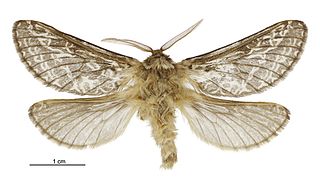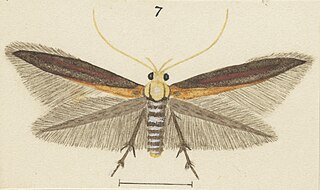
Heloxycanus patricki, also known as the sphagnum porina moth, is a species of moth of the family Hepialidae, the ghost moths. It is the only member of the genus Heloxycanus. This species is endemic to New Zealand. It has been classified as having the status of "At Risk, Declining" by the Department of Conservation.
Izatha dulcior is a species of moth in the family Oecophoridae. It is endemic to New Zealand. This species is classified as "At Risk, Naturally Uncommon" by the Department of Conservation. I. dulcior is the first lepidoptera species described as endemic to the Poor Knights Islands.
Izatha haumu is a species of moth in the family Oecophoridae. It is endemic to New Zealand. This species is classified as "At Risk, Naturally Uncommon" by the Department of Conservation. It is believed to only inhabit the Aupouri Peninsula.
Izatha taingo is a species of moth in the family Oecophoridae. It is endemic to New Zealand. This species is classified as "At Risk, Naturally Uncommon" by the Department of Conservation. It is only known from the Aupouri Peninsula of Northland.
Izatha oleariae is a species of moth in the family Oecophoridae. It is endemic to New Zealand. This species is classified as "At Risk, Naturally Uncommon" by the Department of Conservation. It is only found on the Snares Islands.
Izatha spheniscella is a species of moth in the family Oecophoridae. It is endemic to New Zealand. This species is classified as "At Risk, Naturally Uncommon" by the Department of Conservation. It is only found on the subantarctic Snares Islands.
Izatha gibbsi is a species moth in the family Oecophoridae. It is endemic to New Zealand. This species is classified as "At Risk, Naturally Uncommon" by the Department of Conservation. It is named for George W. Gibbs.
Izatha minimira is a species of moth in the family Oecophoridae. It is endemic to New Zealand. This species is classified as "At Risk, Naturally Uncommon" by the Department of Conservation.

Circoxena ditrocha is a species of moth in the family Blastodacnidae. This species is endemic to New Zealand and has been collected on both the North and South Islands. The habitat of this species is on the edges of native forest or scrub and it may be associated withPseudopanax arboreus. As at 2000 the host species of this moth is unknown but it has been hypothesised that the larvae are seed borers. Adults are on the wing in December to March. It is classified as "At Risk, Naturally Uncommon" by the Department of Conservation.

Aoraia aspina is a species of moth of the family Hepialidae. It was described by John S. Dugdale in 1994 from specimens collected in the Tasman, Otago and Southland districts. It is endemic to New Zealand.

Aoraia lenis is a species of moth of the family Hepialidae. It is endemic to New Zealand. It was described by John S. Dugdale in 1994.

Aoraia rufivena, also known as the rufous-veined aoraia or the Otago ghost moth, is a species of moth of the family Hepialidae. It is endemic to New Zealand. A. rufivena was described by John S. Dugdale in 1994.

Stathmopoda endotherma is a species of moth in the family Stathmopodidae. It is endemic to New Zealand. It is classified as "At Risk, Naturally Uncommon" by the Department of Conservation.

Ericodesma cuneata, the Corokia leafroller moth, is a species of moth in the family Tortricidae. It is endemic to New Zealand. This moth is classified as "At Risk, Naturally Uncommon" by the Department of Conservation.

Orocrambus jansoni is a species of moth in the family Crambidae. It is endemic to New Zealand. This species is classified as "At Risk, Naturally Uncommon" by the Department of Conservation.

Pyrgotis pyramidias is a species of moth in the family Tortricidae. It is endemic to New Zealand. It is classified as "At Risk, Naturally Uncommon" by the Department of Conservation. This species is regarded as having two 'forms' although doubt has been expressed whether these are the same species.

Pyrgotis transfixa is a species of moth of the family Tortricidae. It is endemic to New Zealand. It is classified as "At Risk, Naturally Uncommon" by the Department of Conservation.
Kiwaia jeanae, also known as the Kaitorete jumper or mat daisy jumper, is a species of moth in the family Gelechiidae. It is endemic to New Zealand. This species is classified as "At Risk, Naturally Uncommon" by the Department of Conservation. Both the males and females of this species are brachypterous.

Hierodoris polita is a species of moth in the family Oecophoridae. It is endemic to New Zealand and is found only in the Central Otago region and in the Dunedin area. As at 2005 the larvae have yet to be identified. However it is possible that a specimen may have been collected in leaf litter thus leading to the hypothesis that the species may be a detritivore. The adults of this species prefer open habitat and have mainly been collected on south-facing rocky bluffs. The adult moths are on the wing in October, November and January to March. This species is classified as "At Risk, Naturally Uncommon" by the Department of Conservation.

Lysiphragma argentaria is a species of moth in the family Tineidae. It is endemic to New Zealand. It is classified as "At Risk, Naturally Uncommon" by the Department of Conservation.












